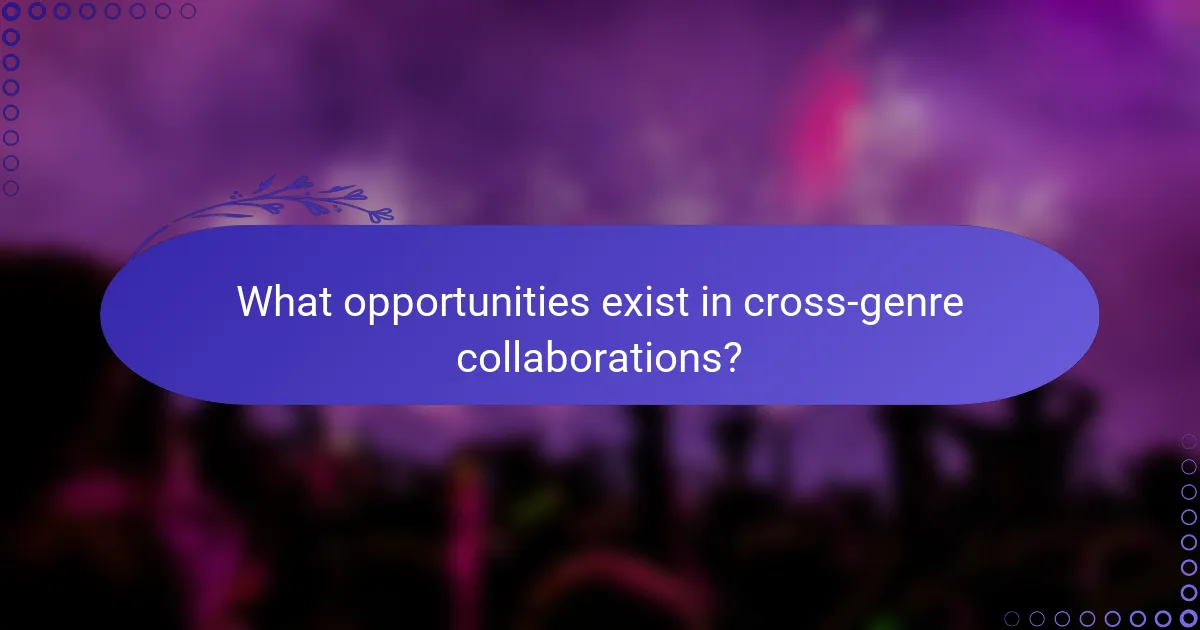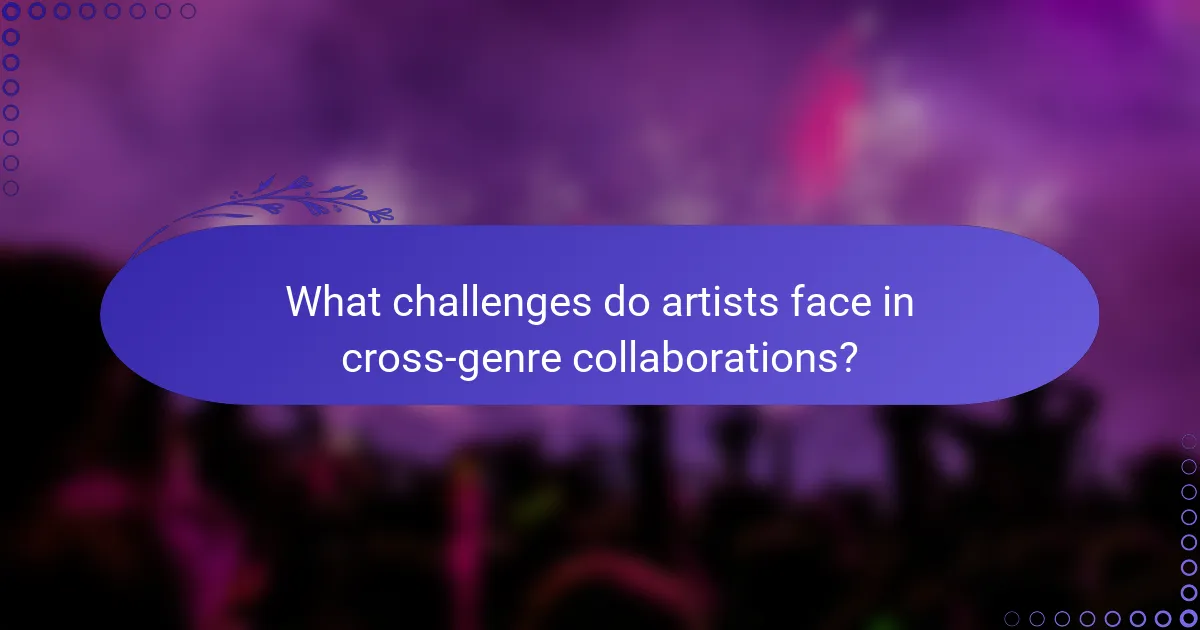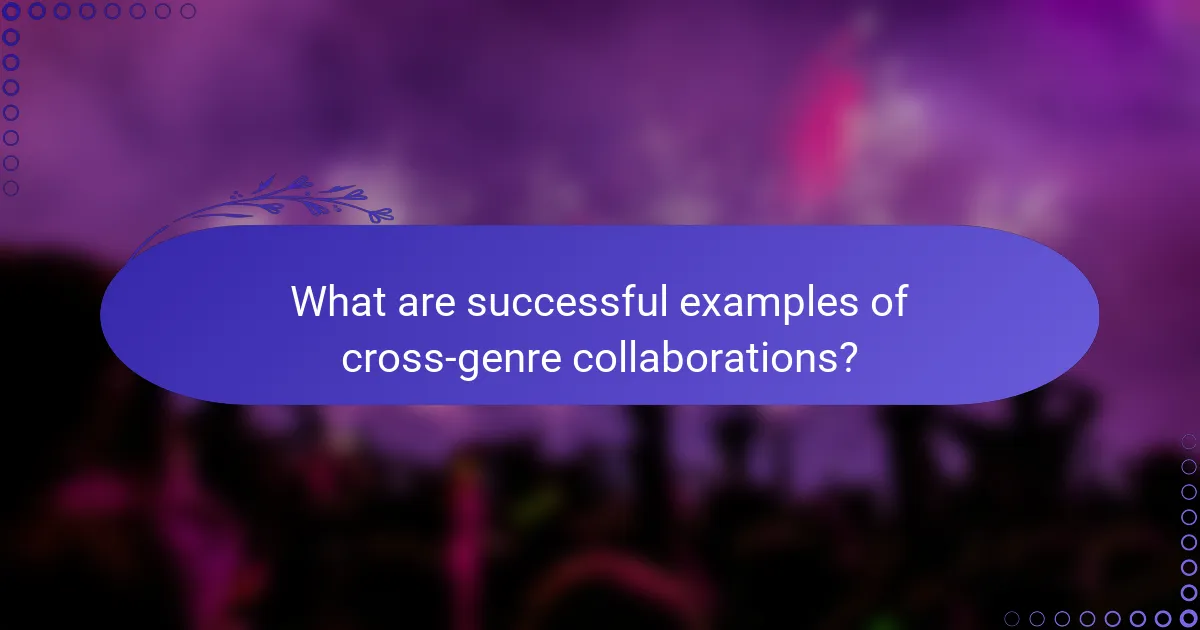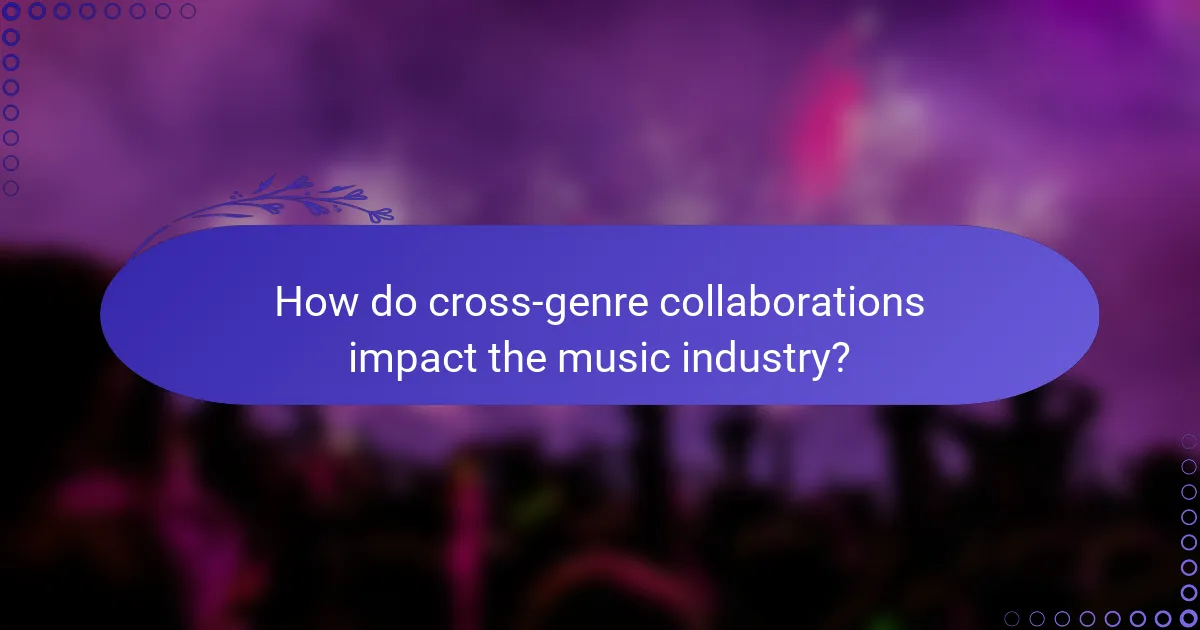Cross-genre collaborations present exciting opportunities for artists to merge diverse styles, expand their audiences, and push creative boundaries. While these partnerships can lead to innovative and engaging content, they also come with challenges such as creative differences and logistical hurdles. By fostering open communication and aligning their visions, artists can navigate these obstacles and create cohesive projects that resonate with a wider range of listeners.

What opportunities exist in cross-genre collaborations?
Cross-genre collaborations offer unique opportunities for artists to blend different styles, reach wider audiences, and innovate creatively. By merging genres, artists can tap into diverse fan bases and explore new artistic territories, leading to fresh and engaging content.
Increased audience reach
Collaborating across genres allows artists to access the fan bases of both genres, significantly expanding their audience reach. For instance, a country artist teaming up with a hip-hop musician can attract listeners from both communities, potentially doubling their exposure.
To maximize this opportunity, artists should promote their collaboration through both genres’ channels, ensuring that marketing efforts resonate with both audiences. Engaging with fans on social media platforms can further enhance visibility and interaction.
Innovation in creative expression
Cross-genre collaborations foster innovation by encouraging artists to experiment with new sounds and styles. This blending of influences can lead to unique musical compositions that challenge traditional genre boundaries.
Artists should embrace the creative process by being open to new ideas and techniques from their collaborators. This willingness to innovate can result in groundbreaking work that stands out in a crowded market.
Access to new markets
By collaborating with artists from different genres, creators gain access to new markets that may have been previously untapped. This can be particularly beneficial in regions where certain genres are more popular, allowing for strategic expansion.
For example, a pop artist working with a Latin musician can introduce their music to the vibrant Latin market, potentially leading to increased sales and streaming numbers. Understanding regional preferences is key to successfully entering these new markets.
Enhanced brand visibility
Cross-genre collaborations can significantly enhance an artist’s brand visibility. When artists from different genres come together, they create a buzz that attracts media attention and can lead to features in various publications.
To leverage this visibility, artists should actively engage with press outlets and utilize social media to share their collaborative efforts. This proactive approach can help maintain momentum and keep the audience engaged.
Collaboration with established artists
Working with established artists from different genres can provide emerging musicians with credibility and exposure. Collaborating with a well-known figure can introduce new artists to a broader audience and enhance their reputation within the industry.
Emerging artists should seek out collaborations that align with their artistic vision and values. Building genuine relationships with established artists can lead to fruitful partnerships that benefit both parties.

What challenges do artists face in cross-genre collaborations?
Artists engaging in cross-genre collaborations often encounter several significant challenges that can hinder the creative process and final output. These challenges include creative differences, market acceptance, logistical coordination, and intellectual property issues.
Creative differences
Creative differences arise when artists from distinct genres have varying artistic visions, styles, and approaches to music. For example, a pop artist may prioritize catchy hooks, while a jazz musician might focus on improvisation and complex harmonies. These differences can lead to conflicts or a lack of cohesion in the final product.
To navigate these creative differences, artists should establish clear communication from the outset. Regular brainstorming sessions and collaborative workshops can help align their visions and foster mutual respect for each other’s artistic processes.
Market acceptance
Market acceptance is another challenge, as audiences may have preconceived notions about specific genres. A collaboration between a country artist and a hip-hop artist might face skepticism from fans of both genres, who may question the authenticity of the fusion. This can impact the commercial success of the project.
To enhance market acceptance, artists can leverage social media and streaming platforms to showcase their collaborative work. Engaging with fans through behind-the-scenes content and live performances can also help build excitement and acceptance for their innovative sound.
Logistical coordination
Logistical coordination involves managing schedules, studio time, and resources across different artists, which can be complex. Artists may be located in various cities or countries, making it challenging to find common availability for recording sessions or promotional events.
To streamline logistics, artists should utilize digital collaboration tools and establish a clear timeline for project milestones. Setting up virtual meetings and using cloud-based platforms for sharing files can also facilitate smoother coordination.
Intellectual property issues
Intellectual property issues can arise when multiple artists contribute to a collaborative project, as ownership rights and revenue sharing must be clearly defined. Disputes over song credits or royalties can lead to legal complications and strain relationships between collaborators.
To avoid these issues, artists should draft a formal agreement outlining the terms of collaboration, including credit attribution and profit distribution. Consulting with a legal professional experienced in music industry contracts can provide additional protection and clarity for all parties involved.

How can artists effectively collaborate across genres?
Artists can effectively collaborate across genres by fostering open communication, aligning their creative visions, and leveraging technology. These elements help bridge the gap between different musical styles, allowing for innovative and cohesive projects.
Establish clear communication
Clear communication is essential for successful cross-genre collaborations. Artists should engage in regular discussions to share ideas, preferences, and feedback. This can prevent misunderstandings and ensure that everyone is on the same page regarding the project’s direction.
Using tools like messaging apps or video calls can facilitate real-time conversations. Setting up a dedicated platform for ongoing dialogue helps maintain transparency and encourages collaboration throughout the creative process.
Define shared goals
Defining shared goals is crucial for aligning the efforts of artists from different genres. Collaborators should discuss their artistic intentions and desired outcomes at the outset. This clarity helps to create a unified vision that respects each genre’s unique characteristics while blending them effectively.
Consider creating a written agreement that outlines the project’s objectives, timelines, and roles. This document can serve as a reference point and help keep the collaboration focused and productive.
Utilize collaborative tools
Utilizing collaborative tools can streamline the creative process for artists working across genres. Platforms like cloud storage services, digital audio workstations (DAWs), and project management software can enhance collaboration by allowing artists to share files and track progress in real time.
For example, using a DAW that supports multiple users can enable artists to work on the same track simultaneously, regardless of their physical location. Additionally, tools like Trello or Asana can help manage tasks and deadlines, ensuring that all collaborators stay organized and engaged.

What are successful examples of cross-genre collaborations?
Successful examples of cross-genre collaborations showcase how artists from different musical backgrounds can create innovative and commercially viable music. These partnerships often blend distinct styles, attracting diverse audiences and expanding creative boundaries.
Post Malone and Ozzy Osbourne
Post Malone and Ozzy Osbourne teamed up for the hit single “Take What You Want,” which combines elements of hip-hop and rock. This collaboration highlights how artists can merge genres to reach a wider audience, with Post Malone’s contemporary sound complementing Osbourne’s classic rock roots.
The partnership also illustrates the importance of mutual respect and understanding between artists from different genres. By blending their unique styles, they created a track that resonates with fans across generations, proving that genre boundaries can be successfully crossed.
Lil Nas X and Billy Ray Cyrus
Lil Nas X’s “Old Town Road,” featuring Billy Ray Cyrus, is a prime example of a cross-genre collaboration that took the music world by storm. This track fuses country and rap, leading to widespread acclaim and commercial success, including breaking records on music charts.
This collaboration emphasizes the power of social media in promoting cross-genre music. The viral nature of the song on platforms like TikTok helped it gain traction, demonstrating how modern marketing strategies can enhance the visibility of genre-blending tracks.
David Bowie and Nine Inch Nails
David Bowie’s collaboration with Nine Inch Nails on the “Outside” album showcases a fusion of rock and industrial music. This partnership allowed Bowie to explore darker themes and electronic sounds, while Nine Inch Nails benefited from Bowie’s iconic status and artistic vision.
Such collaborations can challenge traditional genre definitions and encourage artists to experiment with new sounds. By embracing innovation and taking creative risks, artists like Bowie and Nine Inch Nails can produce groundbreaking music that resonates with diverse audiences.

How do cross-genre collaborations impact the music industry?
Cross-genre collaborations significantly influence the music industry by blending different musical styles, which can lead to innovative sounds and broader audience appeal. These partnerships often challenge traditional genre classifications, creating new opportunities for artists and reshaping market dynamics.
Shifts in genre boundaries
Cross-genre collaborations blur the lines between established music genres, allowing artists to explore diverse influences. For example, a country artist collaborating with a hip-hop musician can create a unique sound that attracts fans from both genres, fostering a more inclusive music landscape.
This shift encourages artists to experiment beyond their typical styles, leading to the emergence of hybrid genres. As a result, listeners may discover new favorites and artists can expand their creative horizons.
New revenue streams
Collaborations across genres can open up various revenue streams, including joint tours, merchandise, and streaming royalties. By combining fan bases, artists can maximize their reach and increase ticket sales during live performances.
Additionally, cross-genre projects often attract sponsorships and partnerships with brands looking to tap into diverse audiences. This can lead to lucrative promotional opportunities that single-genre artists might not access.
Changes in audience demographics
Cross-genre collaborations can significantly alter audience demographics by attracting listeners from different backgrounds. For instance, a collaboration between a pop artist and a jazz musician may draw in fans who typically wouldn’t engage with either genre alone.
This diversification can help artists build a more extensive and varied fan base, leading to increased engagement across social media platforms and streaming services. Understanding these demographic shifts can help artists tailor their marketing strategies to reach new audiences effectively.

What frameworks can guide successful collaborations?
Successful collaborations often rely on established frameworks that facilitate communication, align goals, and manage expectations. Key frameworks include the Collaborative Innovation Framework, the Agile Methodology, and the Design Thinking approach, each offering unique strategies to enhance cross-genre partnerships.
Collaborative Innovation Framework
The Collaborative Innovation Framework emphasizes shared goals and collective problem-solving. It encourages participants from different genres to leverage their unique strengths while fostering an environment of trust and open communication. This approach can lead to innovative outcomes by combining diverse perspectives.
To implement this framework, start by defining a common vision that resonates with all parties involved. Regular check-ins and feedback loops are essential to ensure alignment and adapt to any changes in direction or objectives.
Agile Methodology
The Agile Methodology is a flexible approach that promotes iterative progress through small, manageable increments. This framework allows teams to respond quickly to feedback and changing requirements, making it ideal for cross-genre collaborations where adaptability is crucial.
In practice, teams can hold regular sprint meetings to assess progress and adjust plans accordingly. Establishing clear roles and responsibilities within the team can also enhance efficiency and accountability.
Design Thinking Approach
The Design Thinking approach focuses on understanding user needs and creatively solving problems through empathy and experimentation. This framework is particularly effective in cross-genre collaborations as it encourages participants to step into the shoes of their audience and innovate based on real-world insights.
To apply Design Thinking, start with user research to gather insights, followed by brainstorming sessions to generate ideas. Prototyping and testing concepts with actual users can provide valuable feedback, ensuring that the final product resonates with the target audience.
